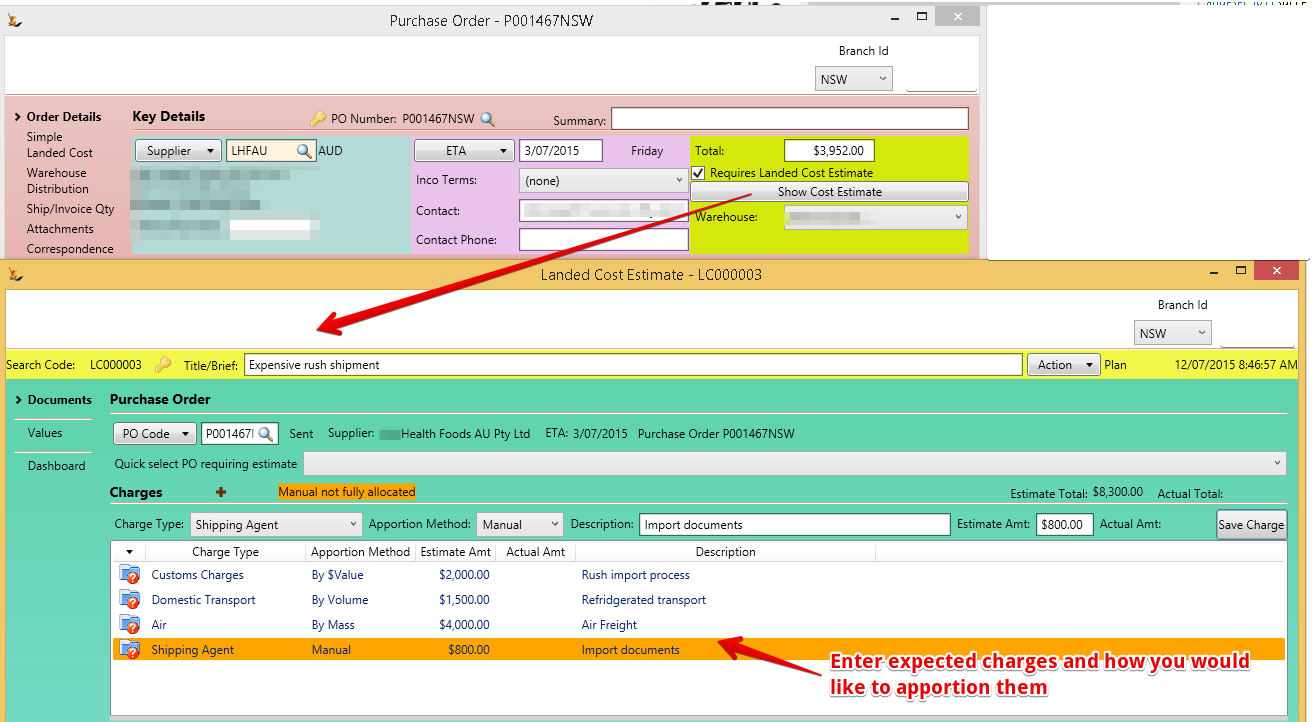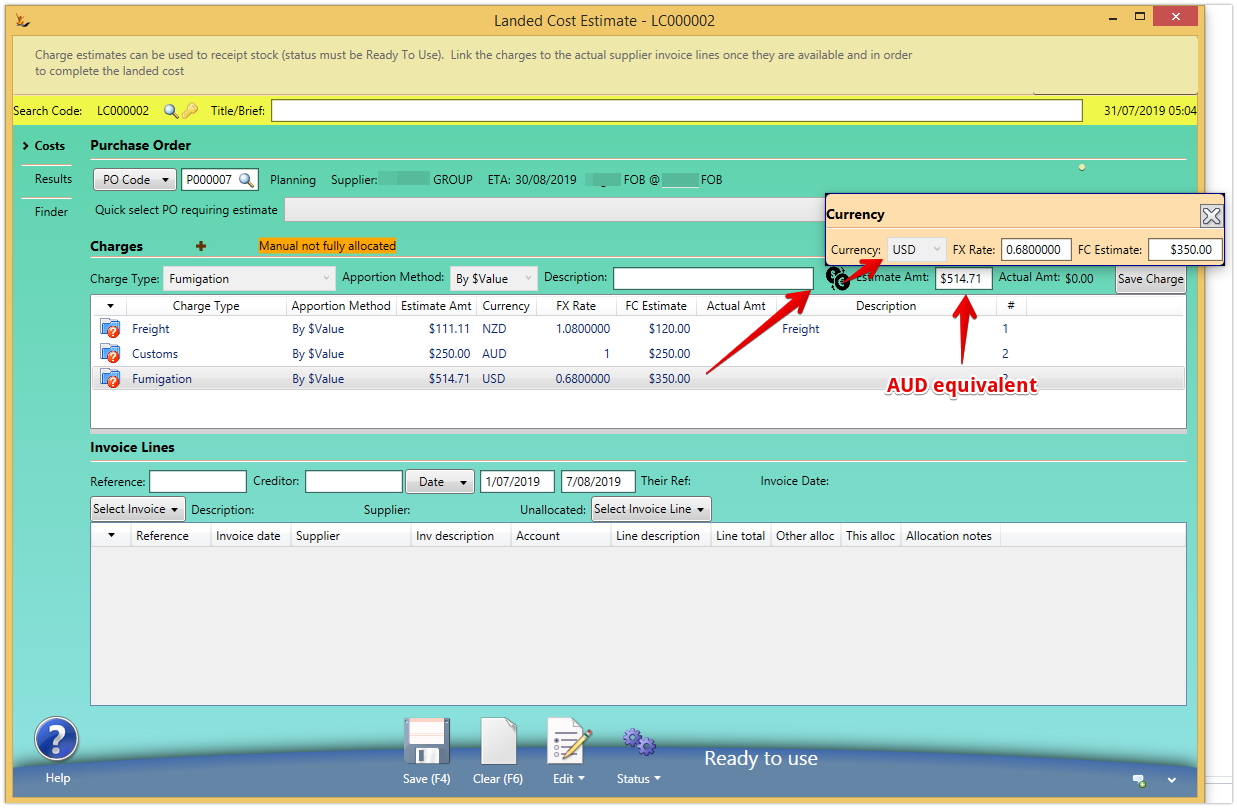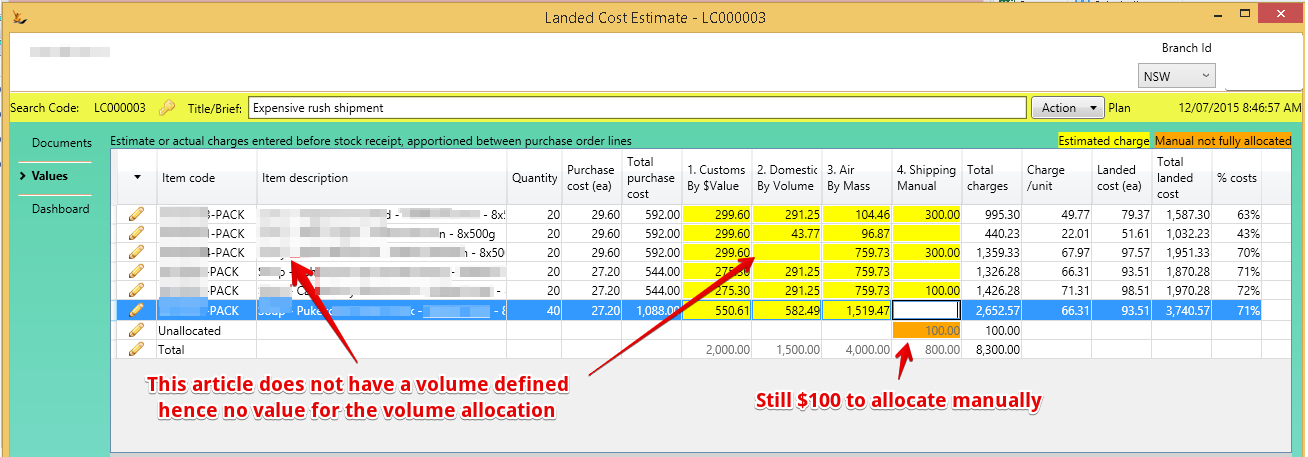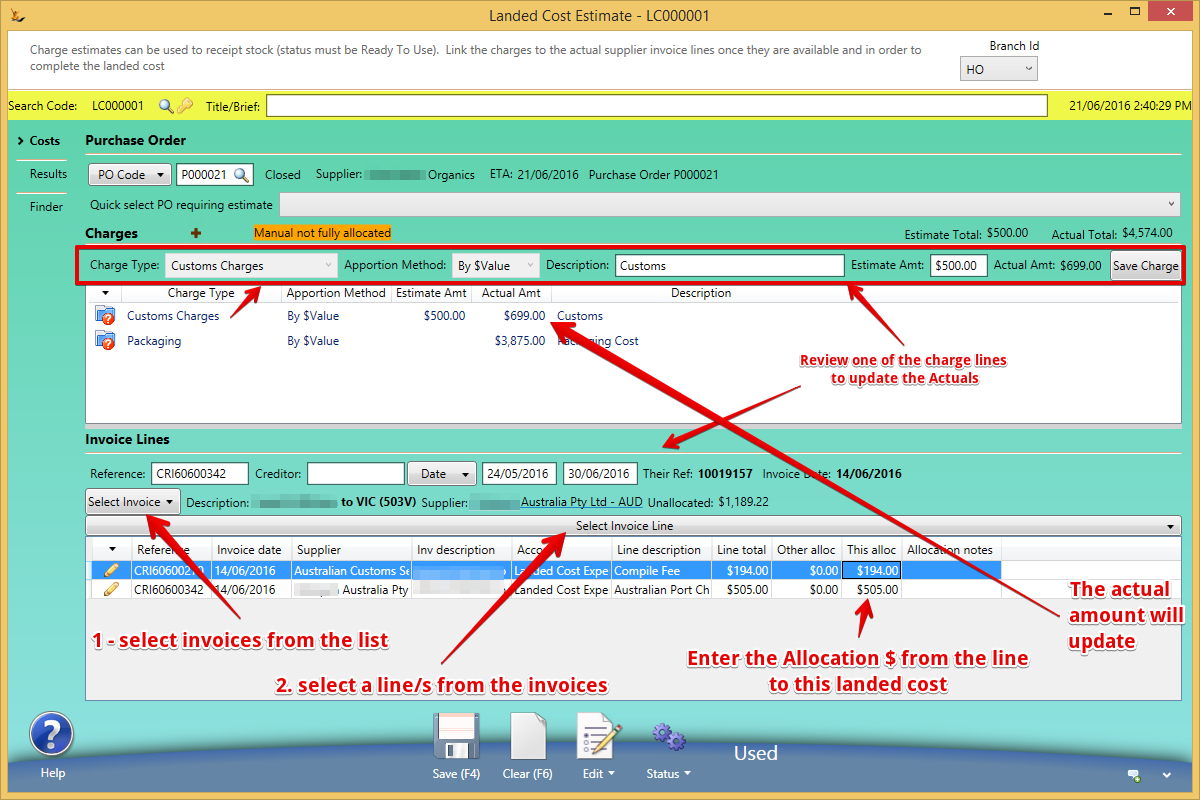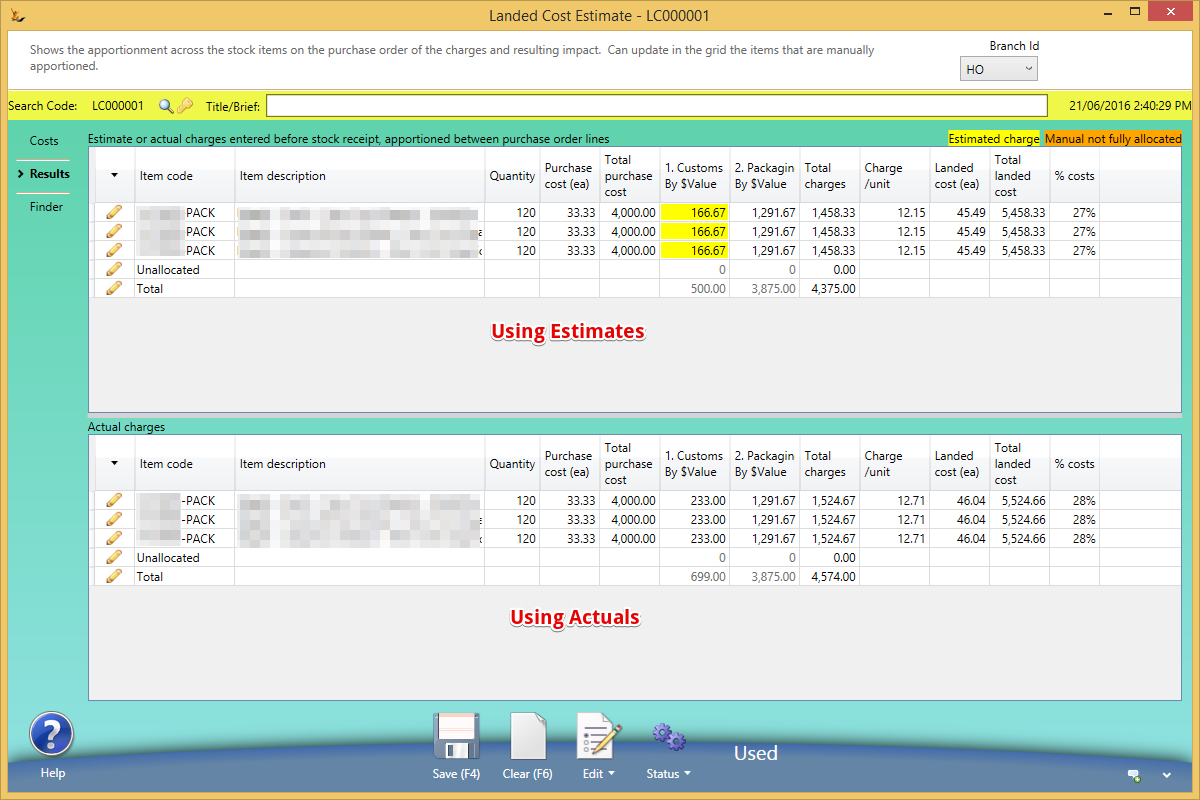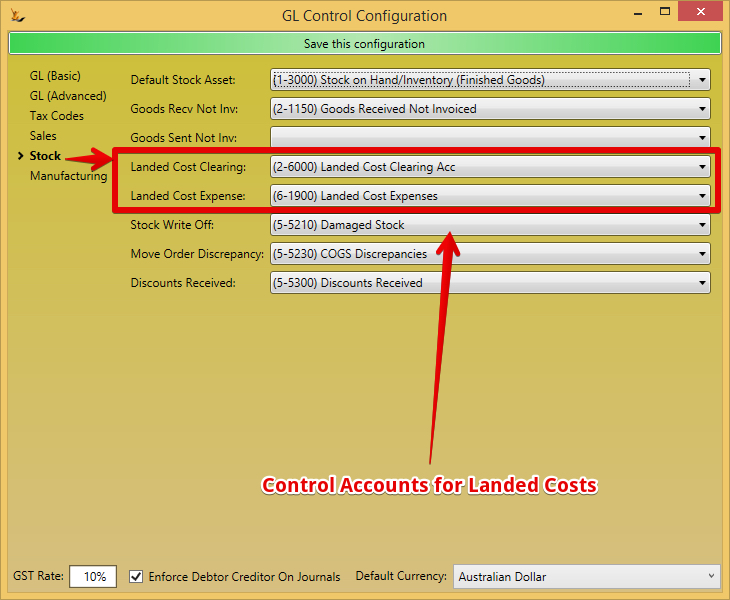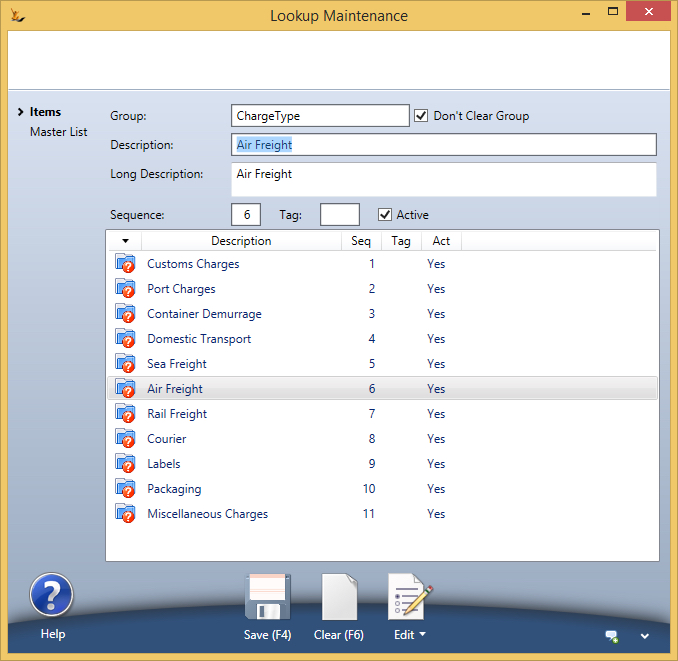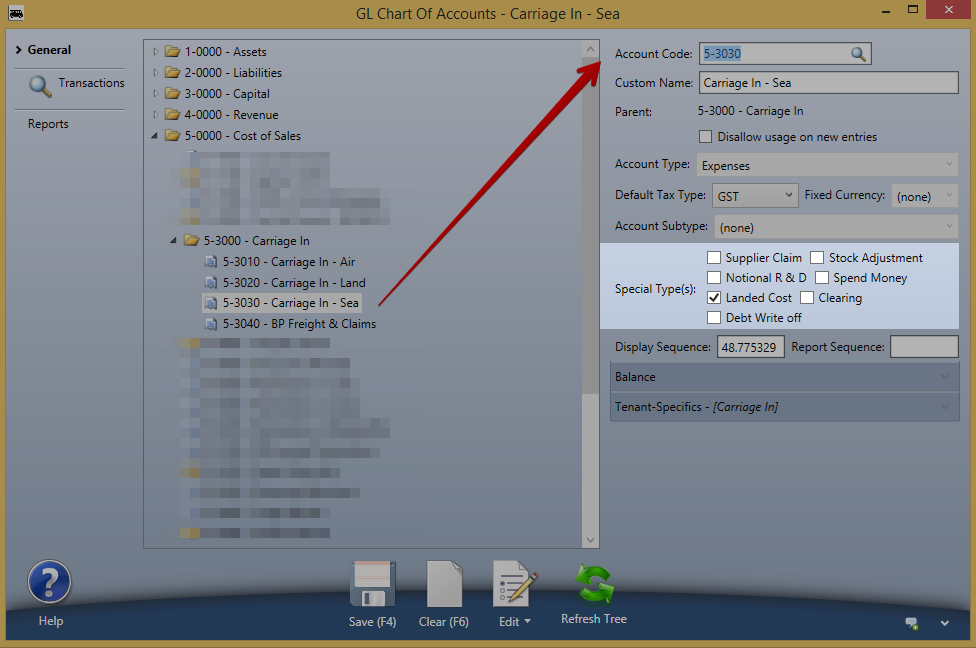Table of contents
| Table of Contents |
|---|
Summary
The landed costing screen is used to enter all the costs that are related to items that are arriving from overseas that you are allowed to add to the value of the item.
There are two stages used because actual costs are often not known until after the products have been receipted into store. Refer to the flow diagram for more details.
...
This document describes Complex Landed Costing process.
For simple landed costing see Simple Landed Costing
To see which purchase orders require action see Purchase Reports Dashboard
General Overview of Landed Costing
Landed costing adds costs incurred in getting the stock into store to the price paid for the stock and updates the average cost in the system
| Note |
|---|
Purchasing JIT items is a special case of landed cost
|
A simple view of what is going on
| Gliffy | ||||||
|---|---|---|---|---|---|---|
|
For the Accountants - here are the journals created.
| Gliffy | ||||||||
|---|---|---|---|---|---|---|---|---|
|
| Note |
|---|
Supplier freight is always allocated to the stock cost. Supplier freight is not known until the supplier invoice is entered and includes freight. The average cost is updated by averaging the freight based on line item value. The average cost update is limited to the value that would have resulted if all the stock is still in the system - if there is less stock remaining than was received then not all the freight will be allocated and some will remain in the "Carriage In" control account If you do not want the freight allocated or you want to allocate it using a different method then enter it as a separate invoice. |
Landed Cost for Drop Ship Purchase Orders
A drop ship purchase order is going direct to the customer and never passes through your warehouse. However it is important to know the cost to you of the goods.
To create a drop ship purchase order - create a sales order and right click on any order lines that will be drop shipped. Then on the created purchase order create a landed cost estimate.
- Landed Cost Estimate form, Results tab:
- If linked PO is a drop ship PO generated from a sales order:
- Show sales order code as a link to open the sales order.
- If sales order customer uses foreign currency:
- Show the currency code and the exchange rate from the SO.
- Add 2 columns showing 'Landed cost (ea)' and 'Total landed cost' converted to the SO customer's currency using the SO FX rate.
- If linked PO is a drop ship PO generated from a sales order:
- On a sales order line with SupplierShip YES, if the generated PO has a Landed Cost Estimate then add a context menu option to open the Landed Cost.
- If the landed cost has charges then 'Calculate and show apportions' and switch to the Results tab.
The landed cost for a drop ship purchase order can be updated from estimate to actuals but is never "Used" by the system to update average cost.
There are two stages in Complex Landed Costs
- Estimated stage = costs are estimated. The PO can be receipted and average cost of the stock will use the estimated costs
- Actual stage = actual costs are compared with the costs used in the estimate stage and the average costs are then adjusted to suit.
Note you can use Manage Shipments incoming to track the containers arriving and count by container.
...
| Note |
|---|
to use Landed costing configurations are required |
...
|
...
|
...
|
...
On the Purchase Order
Set the flag
...
The typical scenario is as follows:
- A number of products are to be imported from an overseas country from a number of suppliers
- Therefore there are multiple purchase orders each with multiple lines on them
- Costs are then incurred
- A shipping company is engaged - and will cost money
- Transport is arranged in the foreign country, travelling to your country and then within your country to your dock
- Export and import fees and duty may apply
- The product is then shipped
- The product arrives in your store and is placed into stock
- Some of this product may be used or sold
- The final charges are presented to you by your suppliers (and not by item or PO)
Because of the timing of the final charges being presented we need to:
- Use estimated values in order to receipt the stock to store and arrive at an approximate cost
- Update the cost once the actuals have been received
Set the Purchase Order to use Landed Costing
Create a Landed Cost Estimate - one for each PO
- Select purchase order that will require landed cost adjustment
- Provide a name
Entering the Charges
| Note |
|---|
Expected charges may be entered as estimates and later (even after stock receipt) linked to the actuals and stock value recalculated if required. FX amounts can be used - they are converted to the base currency for the calculation |
- Enter Type of charge
- Charges are setup at Administration > configuration > Lookups > "ChargeType"
- enter Method of apportioning the charge
- By weight will look at the weight of each item and allocate by weight and is useful for shipping or air freight that is charged by weight
- By Dollar value uses the dollar value on the purchase order
- By volume uses the article volume
- Manual enables you to manually allocate the charges across all related lines
- Foreign currency and conversion rate if required
- Description - add a note to so you can remember what this charge was intended to cover
View the Estimated charges by Purchase Order Line
Action Button: Calculate and show Apportions
Review calculations
Manual values need to be entered in the grid - the remainder will show until you have allocated all the expected cost
Each line will show the purchase order value, the landed costs being added and the final cost ea. This will then be used to update the average cost
New Average cost = (current average cost * current stock qty + qty from the PO * final cost ea) / (current stock qty + PO stock Qty)
Supplier direct to customer (Drop Ship Purchase orders)
Where the supplier is sending direct to a customer a Sales Order lines is marked as Supplier Direct to Customer and on Authorise this creates a PO to the supplier with final address at the customer.
Where the PO has a Complex Landed Cost - the value of the final landed costs in the Sales Order currency is shown for clarity on margin in the sales order currency
Set the Estimate Ready to Use
When you have completed the estimate then Action Button: Set Estimate Ready to use
Receiving Stock - no changes to standard process
| Note |
|---|
Stock can only be received if the Landed Cost Estimate has been set to "Ready to Use" |
Receive stock as normal
- The system will use the calculated average cost for stock value journals - see Purchase Order for Perishable Goods from PO to Goods Receipt
- The Journals created are at the bottom of this page
Landed Cost Estimate recalculates based on actual counts before stock journals created
When the stock is counted the landed cost allocation is updated and recalculated before the Stock Journals are created
- If less stock than was expected is counted during receipt - then the average cost of all items will increase
- If more stock than than was expected is counted during receipt - then the average cost of all items will decrease
...
| Note |
|---|
Note: The $ of the stock placed into Assets will be greater than the amount to be paid to the stock supplier. The balance is placed into a clearing account (see Maintain GL Control Accounts ) until later cleared out when the actual payments/ invoices are linked to the landed cost calculation Once product is receipted the estimated calculations have been used and cannot be changed. |
...
| Note |
|---|
If you do not update the estimate with actuals you will have a balance in the GL Control Account "Landed Cost Clearing Account" Shipping Organisations may pay GST - to enter a 100% GST line on the journal - Choose TAX type of 100% Puts entire amount entered to Tax Column
|
From the Purchase Order
...
from PO to Goods Receipt - open the estimate
Select
...
- Choose the supplier that you paid (or you have an invoice for)
- Choose from a list of invoices / payments from that supplier
- Note that the list of invoices is filtered by (1) those against a GL account flagged as a Landed Cost Account that have not yet been associated with a landed cost
- Determine the amount to use for this landed cost calculation (you can change this later)
...
an invoice to link to and select the line/s on the invoice to use - allocate the amounts to use
- The Invoices listed are all invoices that are listed in GL Accounts with "Landed Cost" special type set
| Note |
|---|
Add additional cost lines if required |
Action Button: Calculate Actual Average costs
Review calculations and adjust manual allocations in the grid
...
. Status "Calculate and Show Apportions"
Finalised Landed Costs
Where changes are to be made to the Average Cost for the Stock Articles
- The average cost of the article will be adjusted to the new average cost
- The new average cost will be applied to the current stock = ((new av cost - current av cost) * Quantity on the PO line ) / total Qty in stock now
- The new average cost will be set regardless of the amount of stock in the system
- Journals will be written including clearing out any balance in the clearing account
- The status will then move to Actual used
...
Landed costing diagram of the flow.
...
The typical scenario is as follows:
- A number of products are to be imported from an overseas country from a number of suppliers
- Therefore there are multiple purchase orders each with multiple lines on them
- Costs are then incurred
- A shipping company is engaged - and will cost money
- Transport is arranged in the foreign country, travelling to your country and then within your country to your dock
- Export and import fees and duty may apply
- The product is then shipped
- The product arrives in your store and is placed into stock
- Some of this product may be used or sold
- The final charges are presented to you
Because of the timing of the final charges being presented we need to:
- Use estimated values in order to receipt the stock to store and arrive at an approximate cost
- Update the cost once the actuals have been received.
| Note |
|---|
If the stock level at the time of applying the actuals is below the quantity of stock on the PO line
To illustrate
|
Landed costing diagram of the flow.
| Gliffy | ||||
|---|---|---|---|---|
|
Accounting Journals
| Journals for receipt of Stock item with locked estimate | Debit | Credit | Estimate of $20 costs |
|---|---|---|---|
| Stock on Hand - assets | 120 |
| Increase in stock value | ||
| Trade Creditors Liabilities |
| 100 | Amount paid to stock supplier | |
| Landed cost clearing account - liabilities |
| 20 | Total allocated other costs for these items based on the estimate | |
| Totals | 120 | 120 |
| Stock Supplier Invoice | Dr | Cr | Payment to supplier for stock |
|---|---|---|---|
| Trade Creditors - Liabilities |
| 100 |
| Goods Received not Invoiced | 100 |
| Total | 100 | 100 |
| CR Invoice Journal for a cost paid (customs) |
|---|
| = must be linked to landed cost clearing account | Dr | Cr | Payment of $25 costs |
|---|---|---|---|
| Trade Creditors - Liabilities |
| 25 |
| Landed cost clearing account | 25 | ||
| Totals | 25 | 25 |
| Once a journal line is linked to a landed cost account | |||
|---|---|---|---|
| Adjustment journal required once actuals are associated | Dr | Cr | Adjustment of stock from $20 estimate to $25 Actual |
| Landed Cost Expenses To Stock - Expense Account |
| 25 | Expense account tracking landed costs in separate account | ||
| Landed cost clearing account - liabilities | 20 |
| Clear the clearing account of the estimate value | |
| Stock on Hand - Assets - Credit | 5 |
| Update the stock on hand with the increase (Decrease) in value required | |||
| Totals | 25 | 25 | Result = Stock increases $5 (now $25 more than paid to stock supplier) and Landed Cost Clearing account = 0 Landed cost expense account = Actual = $25 |
| Adjustment Journal if Actuals are used prior to stock receipt | Dr | Cr | When $25 actuals are known prior to receipt of stock |
|---|---|---|---|
| Stock on Hand - assets | 125 |
| Increase in stock value | ||
| Trade Creditors Liabilities |
| 100 | Amount to be paid to stock supplier | ||
| Landed cost expenses to stock - expense account |
| 25 | Expense account tracking landed costs in separate account | ||
| Totals | 125 | 125 | Result = Stock increases $25 more than paid to stock supplier Landed cost expense account = Actual = $25 |
GL Control Accounts for Landed Costing
So two new control accounts have been added to Maintain Control accounts in GL Control Accounts
- Landed Cost clearing account
- Filled with values when stock is receipted using estimated costs
- Cleared once known costs are allocated
- Landed Cost Expense account
- Tracks all costs that have been added to stock as part of an actual landed cost update
Example Charge Types Configuration
Setup in Lookups screen
GL Account configuration to show invoices in landed cost Actuals list
Landed Cost Audit
Landed cost calculations are complex and it is important that the actual cost update reflects accurately the journaled amount. Because the average cost of a SKU is to two decimal places (as required by COGS journals) there is commonly a rounding difference.

